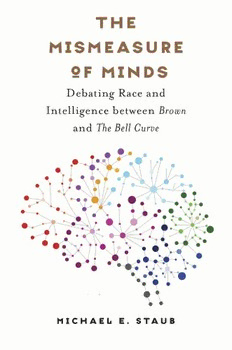
The Mismeasure of Minds: Debating Race and Intelligence Between Brown and the Bell Curve PDF
Preview The Mismeasure of Minds: Debating Race and Intelligence Between Brown and the Bell Curve
The Mismeasure of Minds StudieS in Social Medicine Allan M. Brandt, Larry R. Churchill, and Jonathan Oberlander, editors This series publishes books at the intersection of medicine, health, and society that further our understanding of how medicine and society shape one another historically, politically, and ethically. The series is grounded in the convictions that medicine is a social science, that medicine is humanistic and cultural as well as biological, and that it should be studied as a social, political, ethical, and economic force. The Mismeasure of Minds Debating Race and Intelligence between Brown and The Bell Curve Michael E. Staub The University of North Carolina Press Chapel Hill © 2018 The University of North Carolina Press All rights reserved Designed by April Leidig Set in Warnock by Copperline Book Services Manufactured in the United States of America The University of North Carolina Press has been a member of the Green Press Initiative since 2003. Jacket illustration © iStockphoto.com/Hendra Su. Library of Congress Cataloging- in- Publication Data Names: Staub, Michael E., author. Title: The mismeasure of minds : debating race and intelligence between Brown and The bell curve / Michael E. Staub. Other titles: Studies in social medicine. Description: Chapel Hill : The University of North Carolina Press, [2018] | Series: Studies in social medicine Identifiers: lccn 2018016978| iSBn 9781469643595 (cloth : alk. paper) | iSBn 9781469643601 (ebook) Subjects: lcSH: Intellect—Social aspects—United States. | Intelligence levels— Social aspects—United States. | Intelligence tests—Social aspects—United States. | Racism—United States—Psychological aspects. | Intellect—Genetic aspects. | Eugenics—United States—History. | Educational psychology—United States. | School integration—United States. | Segregation in education—United States. | Topeka (Kan.). Board of Education—Trials, litigation, etc. | Brown, Oliver, 1918–1961—Trials, litigation, etc. | Herrnstein, Richard J. Bell curve. Classification: lcc BF431.5.u6 S73 2018 | ddc 153.9089—dc23 lc record available at https://lccn.loc.gov/2018016978 A shorter version of chapter 3 appeared in Michael E. Staub, “The Other Side of the Brain: The Politics of Split- Brain Research in the 1970s–1980s,” History of Psychology 19, no. 4 (2016): 259–73 (© 2016 American Psychological Association). A prior version of chapter 4 appeared as Michael E. Staub, “Controlling Ourselves: Emotional Intelligence, the Marsh-mallow Test, and the Inheritance of Race,” American Studies 55 (Spring 2016): 59–80. Lucy This page intentionally left blank Contents Introduction 1 one Plasticity of Intelligence, Education Reform, and the Disadvantaged Child 17 two Minimal Brain Dysfunction, Ritalin, and Racial Politics 49 tHree The Politics of Cerebral Asymmetry and Racial Difference 79 Four A Racial History of Emotional Intelligence 109 Five Neuroscience, Race, and Intelligence after The Bell Curve 139 Afterword 169 Acknowledgments 173 Notes 175 Index 211 This page intentionally left blank Figures 1. Arthur R. Jensen in 1970 5 2. Richard M. Nixon with Daniel Patrick Moynihan in 1970 21 3. Ernest Chambers in 1968 51 4. Mark A. Stewart in 1967 61 5. Photomontage in the Journal of Learning Disabilities, 1970 65 6. Advertisement for Ritalin in the American Journal of Diseases of Children, 1971 68 7. Vint Lawrence cartoon in the New Republic, 1997 76 8. Roger W. Sperry around 1970 84 9. Joseph E. Bogen in the mid- 1980s 86 10. Illustration by Bogen from 1975 87 11. New Yorker cartoon by Lee Lorenz, 1977 104 12. Advertisement for a “Don’t Eat the Marshmallow!” coffee mug 112 13. “Human Beings Are Not Very Easy to Change after All,” Saturday Review, 1972 125 14. From Neurons to Neighborhoods graph, 2000 154
